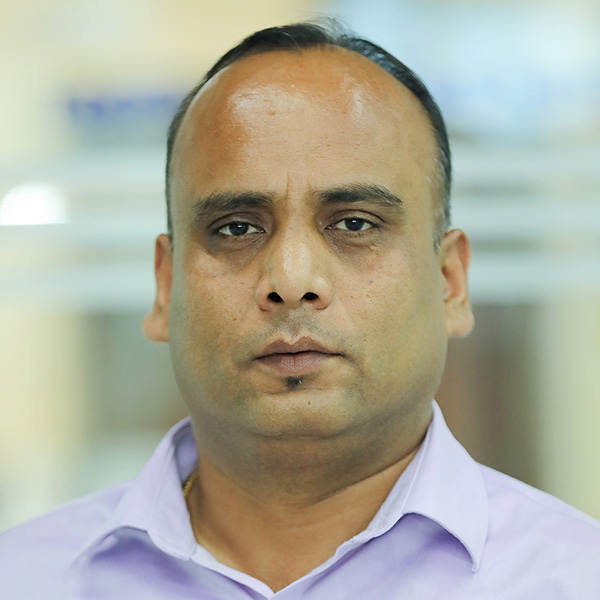Politics
Rabindra Adhikari, who rose from a student leader to national politics, dies in a helicopter crash
Rabindra Adhikari, along with six other people were killed after an Air Dynasty helicopter crashed into a cliff in Taplejung.
Anil Giri
When Rabindra Adhikari took the reins of the tourism ministry in March last year, he set sights on steering the country’s aviation sector. But weeks shy of one year in office, he died in a helicopter accident on Wednesday.
Adhikari, 49, along with six other people were killed after an Air Dynasty helicopter crashed into a cliff in Taplejung. The minister was in the neighbouring Tehrathum district to attend a programme related to aviation—he had been leading a team at Chuhandanda to study the possibility for an airstrip.
A student leader turned national-level politician, Adhikari was seen as one of the promising faces in the KP Oli Sharma Cabinet. Those who knew him—and worked with him closely—remember him as a “soft-spoken” and “always smiling” individual.
As a student leader, Adhikari led campaigns against privatisation in the education sector, encroachment in Kalapani, Indian dams built along the border, and atrocities of the royal palace among others. He also led a campaign to ensure 33 percent discount for students when travelling on public vehicles.
“He was a rebellious leader during his college days at Prithvi Narayan Campus in Pokhara,” said Dhan Raj Gurung, a Nepali Congress leader from Syangja, Adhikari’s neighbouring district, recalling Adhikari’s fierce leadership during his days in college.
Born in Kaski district, Adhikari made his foray into politics as a member of the student wing of the Nepal Communist Party (Marxist-Leninist) in 1989, a year before the fall of the Panchayati regime. He quickly rose through the ranks and, in 1999, became the national president for All-Nepal National Free Student Union, the student wing of the communist party.
When he joined the Tribhuvan University campus in Kirtipur, it did not take him long to become the students’ favourite leader, largely because of his ability to engage with conversations and his sharp political understanding.
Recognising his potential, his party, which had become Nepal Communist Party (Unified Marxist Leninist), picked him as the party’s candidate for the Constituent Assembly elections held in 2008 from Kaski-2. Adhikari won.
He was a member of several parliamentary committees, including the Public Accounts Committee, and led several sub-committees which took some crucial decisions on a host of issues ranging from hydropower to public corporation to radio frequency to industry to machine-readable passport, among others.
When the second Constituent Assembly elections were held in 2013, the party once again chose him as a candidate. Once again, he did not disappoint his party leadership.
In his second stint in the constituent assembly, he was elected chairman of the Development Committee of Parliament, where he would bring Nepal’s development model to lively debates. He played a crucial role in deciding some national pride projects. He was active in expediting the Melamchi Drinking Water project, mid-hill highway, Kathmandu-Tarai Fast Track project, second international airport in Bara, Pokhara International Airport and Gautam Buddha International Airport in Bhairahawa.
Even his opponents admired his political understanding.
Gagan Thapa, a Nepali Congress leader and a long-time friend of Adhikari, remembers him as an impressive student leader with the ability to work with members of different political party leaders regardless of their ideologies.
“As a student leader, he lifted the image of his party organisations,” Thapa told the Post. “He was confident that the image of his party that had sunken because of division could be boosted by student groups through the organisation of skills and popular campaigns.
After he was elected in the 2017 elections, Adhikari was appointed to lead the Ministry of Tourism, Culture and Civil Aviation. Immediately after assuming office, he took major initiatives to revamp Nepal’s tourism and civil aviation sector, something he had long developed a penchant for. But that also quickly landed him in controversy.
When the two Airbus wide-body aircraft landed in Kathmandu after years-long negotiations, Adhikari was at the helm of the Tourism Ministry. His excitement was publicly visible when he talked about the newly arrived aircraft. But after the plane purchase deal ran into controversy, a parliamentary committee in its investigation concluded that there was a misappropriation of over Rs4 billion in the deal. Though he was not implicated, the House committee recommended that Adhikari take moral responsibility for releasing the last instalment of the money for buying the planes. The case is currently with the Commission for Investigation of Abuse of Authority.
The aircraft purchase deal controversy came as a blot in Adhikari’s image and he, until recent months, continued to face criticism on several forums.
But as both Thapa and Gurung said, Adhikari had developed an uncanny habit of absorbing criticism with a smile. “He was always ready to debate and discuss on the issues. He was not offended by criticisms hurled at him,” Thapa told the Post.
Adhikari, who has written various articles for newspapers on contemporary issues, has two books under his name—“The Road to Prosperity” and “Constituent Assembly: Democracy and Restructure.”
On Wednesday morning, shortly before the crash, Adhikari delivered a brief speech at a programme in Tehrathum’s Aathrai Rural Municipality.
“Within a few years, the distance between Kathmandu and Aathrai will only be a few hours,” he said. But for Adhikari, and the rest of the passengers on the Air Dynasty flight, the distance from Aathrai to Kathmandu was simply too long to cover.
He is survived by his wife and two sons.




 24.05°C Kathmandu
24.05°C Kathmandu














